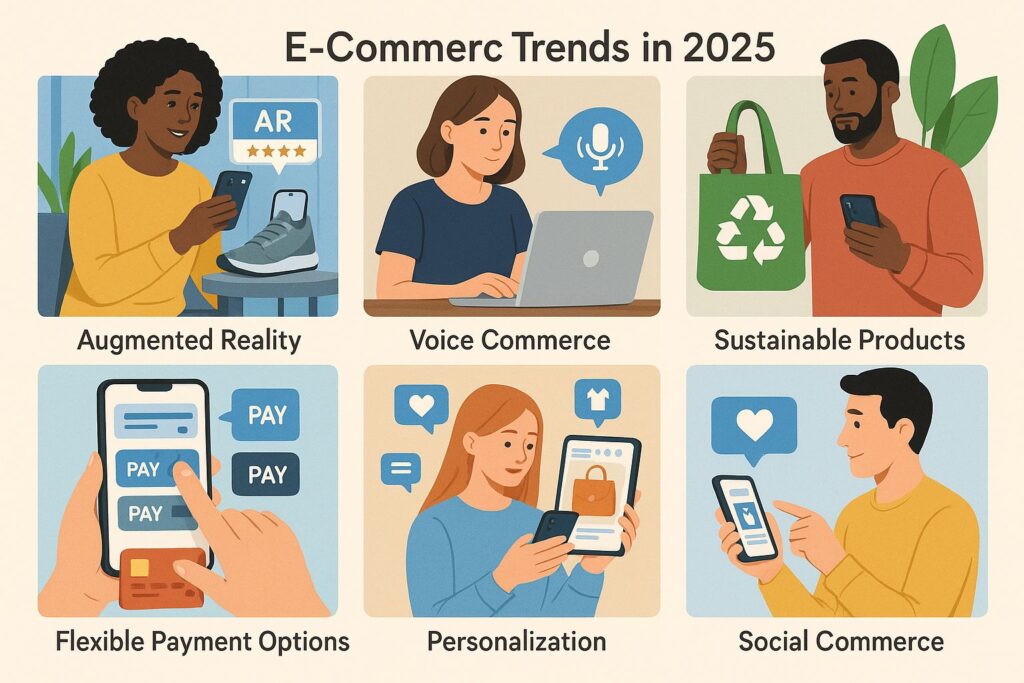
In 2025, e-commerce will look very different from what it did a few years ago. Online shopping has become clever, sharp, and more individual, with the speed of electricity and continuously on consumer expectations. Businesses suited to these changes are getting rid of them, while they are stuck in the previous risk.
So, are the shopkeepers looking really in 2025? Let’s find out the latest e-commerce trends that shape customer behavior and find out how businesses can keep up.
1. Hyper-Personalized Shopping Experience
Shopkeepers no longer want size-fit-all product recommendations. In 2025, privatization must be one. Thanks to Artificial Intelligence, corporations now provide customized suggestions, personalized discounts, and curated collections for every customer.
Consumers appreciate it while brands take into account their options, from size and coloration to style and finances. It not only makes convenience but also loyalty.
2. Social Commerce Takes the Lead
Social media platforms are no longer for browsing – they are rich marketplaces. Shopkeepers now expect to buy directly through Instagram, TikTok, or Facebook without leaving the app. Influencer-powered shopping, live product demos, and instant checkout options in 2025 are changing social commerce into one of the fastest-growing trends.
Brands integrating e-commerce with social platforms are captured by a small, highly busy audience.
3. Voice and Visual Search
Typing is becoming less common. With smart assistants and advanced cameras, voice and visual search are uplifted. Shopkeepers can now say what they want or snap a picture, and the system immediately finds similar products online.
This trend highlights the need for businesses to they can customize their product listing for both spoken keywords and image recognition.
4. Fast and Greener Deliveries
The speed and stability for shopkeepers in 2025 are top priorities. The equal-day delivery is no longer a luxury- it’s a mile an expectation. However, purchasers additionally need environmentally friendly options, including electric-powered shipping motors, recycling packaging, and carbon-neutral shipping.
Companies that stabilize the fast provider with sustainable practices stand out as a favorite amongst conscious clients.
5. Augmented Reality (AR) Shopping
Trying before purchasing has taken a digital jump. AR shopping tools allow customers to see how furniture looks in their home, or how makeup shades match their skin tone, before shopping.
It not only reduces returns rates, but also makes trusts. For shopkeepers, it seems that the store has to be brought directly into their house.
6. Subscription Models with Flexibility
Membership is ending in 2025, but customers now demand flexibility. Instead of closing in rigid plans, shopkeepers prefer services that allow them to pause, swap, or customize their membership.
From dining kits to fashion boxes, personal, commitment-free membership businesses are winning long-term customers.
7. Seamless Omnichannel Experiences
Shopkeepers want to move smoothly between online and offline purchasing. For instance, they are able to browse online merchandise, take a look at them in-store, and order them through an app. Businesses creating seamless omnichannel experiences – where websites, apps, and physical stores are connected – are distributed to modern consumers.
This trend proves that online shopping does not replace offline – it is a complement.
8. Secure and Flexible Payment Options
In 2025, the payment facility will be important. Shopkeepers expect multiple payment methods to Buy Now, Pay Later (BNPL) services, now from digital wallets and cryptocurrency. At the same time, they want to ensure that their transactions are safe.
Secure, business-free checkouts are investing in trouble-free checkouts are looking at high conversion rates and strong beliefs.
9. Ethical and Transparent Brand
Beyond the products, consumers want to know how brands operate. Sourcing, impartial wages, and stability efforts strongly affect the decisions to buy decisions. Shopkeepers are more likely to support brands that openly share their values and moral practices.
This change suggests that in 2025, customers do not only buy products – they buy in brands that align with their principles.
10. AI-Powered Customer Support
Emails are endless, waiting days for answers. In 2025, shopkeepers are expected to provide immediate help through the AI-Interested Chatbots, Virtual Assistant, and 24/7 Support System. These devices quickly resolve common issues, giving the option to connect with humans for complex questions.
This balance of speed and privatization makes customer service a central part of e-commerce success.
Why These Trends Matter
The e-commerce scenario is developing as shopkeepers are developing themselves. Today’s Customer Price:
- Convenience – Rapid delivery, simple payment, and easy returns.
- Personalization – Shopping that seems unique and sewn.
- Sustainability – Environmental practices that reduce environmental effects.
- Trust – Transparency, Safety and Responsible Service.
Businesses that recognize those needs no longer best entice customers, but additionally earn lengthy-time period loyalty.
Conclusion
The e-commerce trends of 2025 show a clear sample: shopkeepers need experiences that are sharp, personal, durable, and dependable. From AR shopping and social commerce to green delivery solutions and AI-Powered support, the future of online retail is customer-centered as ever before.
For businesses, the challenge is clear – quick adaptation or risk is being left behind. For shopkeepers, the future of e-trade promises greater comfort, more alternatives, and better alignment with private values.
So, next time you shop online, note how lots of these tendencies are already shaping your experience. There is an opportunity, they may soon sense like the new ordinary.

